
A railroad car, railcar, railway wagon, railway carriage, railway truck, railwagon, railcarriage or railtruck, also called a train car, train wagon, train carriage or train truck, is a vehicle used for the carrying of cargo or passengers on a rail transport network. Such cars, when coupled together and hauled by one or more locomotives, form a train. Alternatively, some passenger cars are self-propelled in which case they may be either single railcars or make up multiple units.

Multiple-unit train control, sometimes abbreviated to multiple-unit or MU, is a method of simultaneously controlling all the traction equipment in a train from a single location—whether it is a multiple unit comprising a number of self-powered passenger cars or a set of locomotives—with only a control signal transmitted to each unit. This contrasts with arrangements where electric motors in different units are connected directly to the power supply switched by a single control mechanism, thus requiring the full traction power to be transmitted through the train.
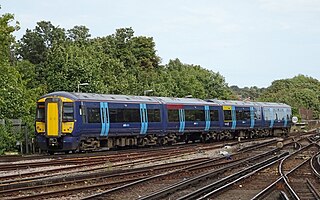
The British Rail Class 375 Electrostar is an electric multiple unit train that was built by Bombardier Transportation at Derby Litchurch Lane Works, from 1999 to 2005. The class form part of the Electrostar family of units, which also includes classes 357, 376, 377, 378, 379 and 387, the most numerous type of EMU introduced since the privatisation of British Rail.

A coupling or coupler is a mechanism, typically located at each end of a rail vehicle, that connects them together to form a train. The equipment that connects the couplers to the vehicles is the draft gear or draw gear, which must absorb the stresses of the coupling and the acceleration of the train.

The British Rail Class 220 Voyager is a class of diesel-electric high-speed multiple unit passenger trains built in Belgium by Bombardier Transportation in 2000 and 2001. They were introduced in 2001 to replace the 20-year-old InterCity 125 and almost 40-year-old Class 47-hauled Mark 2 fleets operating on the Cross Country Route. They were initially operated by Virgin CrossCountry and since 2007 have been operated by CrossCountry.
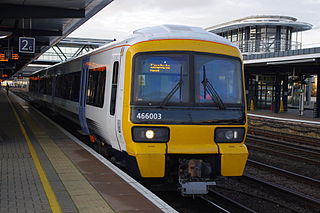
The British Rail Class 466 Networker are a fleet of 43 electric multiple units that were built by Metro-Cammell in 1993 and 1994. The units are currently operated by Southeastern.

An electric multiple unit (EMU) is an electric self-powered train, capable of operating in multiple with other EMUs and without the need for a locomotive; these are typically passenger trains with accommodation in every vehicle and a driving position at each end. The term can also be used to describe a train that is a permanent formation with a non-driving power car, such as the Advanced Passenger Train. As of December 2010, two-thirds of the passenger carriages in Great Britain are formed in EMUs.
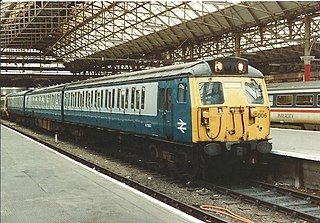
The British Rail Class 304 were AC electric multiple units designed and produced at British Rail's (BR) Wolverton Works.
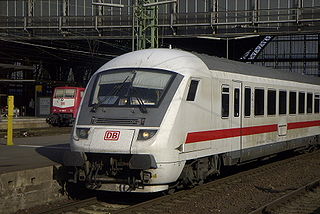
A control car, cab car, control trailer, or driving trailer is a non-powered rail vehicle from which a train can be operated. As dedicated vehicles or regular passenger cars, they have one or two driver compartments with all the controls and gauges required to remotely operate the locomotive, including exterior locomotive equipment such as horns, bells, ploughs, and lights. They also have communications and safety systems such as GSM-R or European Train Control System (ETCS). Control cars enable push-pull operation when located on the end of a train opposite its locomotive by allowing the train to reverse direction at a terminus without moving the locomotive or turning the train around.

The Pioneer III railcar was a short/medium-distance coach designed and built by the Budd Company in 1956 with an emphasis on weight savings. A single prototype was built, but declines in rail passenger traffic resulted in a lack of orders so Budd re-designed the concept as an electric multiple unit (m.u.). Six of the EMU coach design were purchased by the Pennsylvania Railroad with the intention of using them as a high-speed self-contained coach that could be used for long-distance commuter or short-distance intercity travel in the Northeast U.S. The 6 production Pioneer III units were the first all-stainless-steel-bodied EMU railcar built in North America and, at 90,000 pounds (41,000 kg), the lightest.

The Scharfenberg coupler is a commonly used type of fully automatic railway coupling.
Electronically controlled pneumatic brakes are a type of railway braking systems.
The railcar couplers or couplings listed, described, and depicted below are used worldwide on legacy and modern railways. Compatible and similar designs are frequently referred to using widely differing make, brand, regional or nick names, which can make describing standard or typical designs confusing. Dimensions and ratings noted in these articles are usually of nominal or typical components and systems, though standards and practices also vary widely with railway, region, and era. Transition between incompatible coupler types may be accomplished using dual couplings, a coupling adapter or a barrier wagon.

The C-AKv is a fully automatic coupler design, also known as the Faiveley Transpact; it is a hybrid compatible with both buffers and chain couplers and Russian SA3 couplers, intended as an option for the long delayed EU transition to center buffer couplers. C-AKv is an abbreviation of Compact Automatische Kupplung vereinfacht in German, translating to Compact Automatic Coupler simplified in English.
Janney couplers are a semi-automatic form of railway coupling that allow rail cars and locomotives to be securely linked together without rail workers having to get between the vehicles. They are also known as American, AAR, APT, ARA, MCB, knuckle, Buckeye, tightlock, Henricot or Centre Buffer Couplers.
From time to time, a railway decides that it needs to upgrade its coupling system from one that is proving unsatisfactory, to another that meets future requirements. This can be done gradually, which can create many problems with transitional incompatibilities, or overnight, which requires much planning.
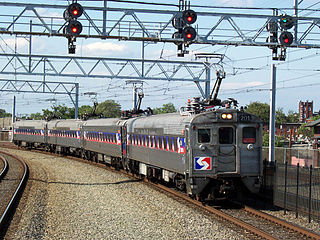
The Budd Silverliner was a model of electric multiple unit railcar designed and built by the Budd Company with 59 examples being delivered starting in 1963. Fifty-five of the cars were purchased for the Reading and Pennsylvania Railroads with public funds for use in Philadelphia, Pennsylvania, area commuter rail service with the remaining 4 cars being purchased by USDOT for use in high-speed rail experiments in 1965. Based on a series of 6 prototype Pioneer III cars built in 1958, the Silverliners represented the first production order of "modern" commuter MU equipment purchased by either railroad and earned their name from their unpainted stainless steel construction which contrasted with the painted carbon steel bodies of the pre-war MU fleets. The cars became a fixture of SEPTA Regional Rail service providing the name to their entire series of EMU railcars before finally being retired in 2012 after 49 years in service.

The Taiwan Railway EMU100 series was a set of rail cars fabricated by British Rail Engineering Limited and the General Electric Company in 1976 that has operated in Taiwan. The alternating current electric multiple unit (EMU) fleet entered full squadron service in 1979, and was withdrawn from service in 2009. This class of railcars were the first to operate on the electric Tzu-Chiang Express. Due to the unit's British origin, rail buffs have variously nicknamed them "British Girl", "British Lady", or "British Grandma".
Buffers and chain couplers are the de facto International Union of Railways (UIC) standard railway coupling used in the EU and UK, and on some surviving former colonial railways, such as in South America and India, on older rolling stock. Buffers and chain couplers are an assembly of several devices: buffers, hooks and links, or turnbuckle screws.

Different types of railroad rolling stock have different couplers depending on the purpose and type of equipment being used and its intended destination. European rolling stock tend to use buffers and chain couplers while American rolling stock uses a Janney coupler or "knuckle coupler". These are incompatible with each other, but where some railroads have obtained older, less expensive used rolling stock from different countries or regions, instead of having to standardize on one form of coupler, it may be useful to be able to use either type of coupler on a piece of rolling stock without having to remove anything.























